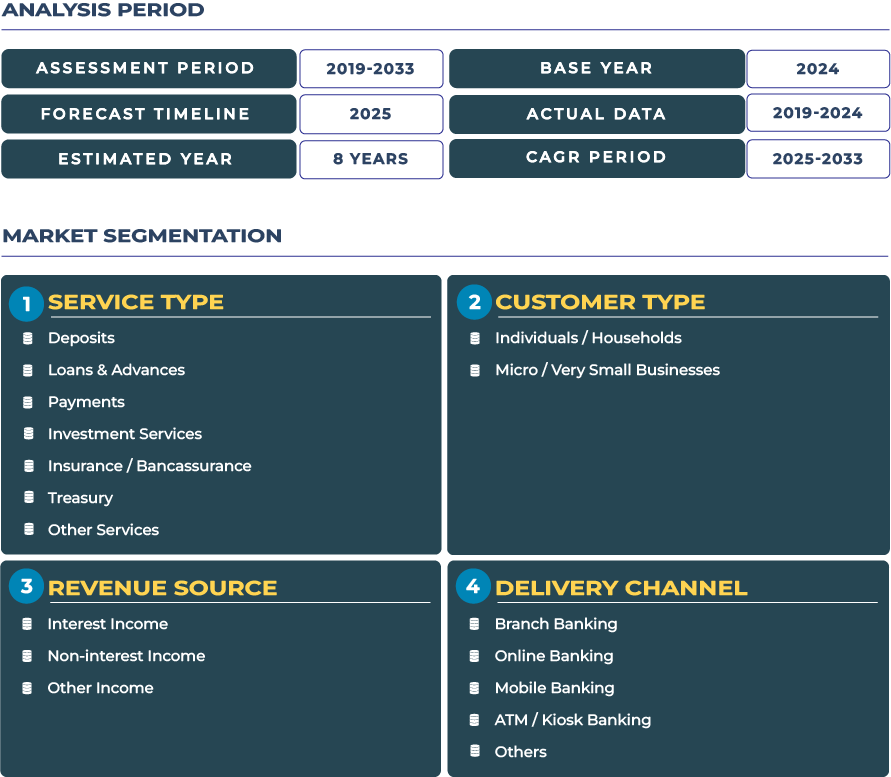Secure & Blockchain-Enabled Banking: Germany Retail Banking Market Under Reinvention
Germany is emerging as a strategic frontier for retail banking transformation, leveraging blockchain frameworks, AI advisory engines, and tight security protocols to preserve trust while unlocking innovation. Institutions are investing in distributed ledger infrastructure to facilitate faster settlement, stronger identity control, and transaction auditability-all while embedding advanced analytics into the customer journey.
Note:* The market size refers to the total revenue generated by banks through interest income, non-interest income, and other ancillary sources.
Market Outlook: Pathways to Scale in Germany Banking Reintegration
Between 2025 and 2033, the German retail banking market is forecast to grow from USD 120.5 billion to USD 148.4 billion, a steady CAGR of 2.6%. Traditional banking lines-such as current accounts, mortgage lending, consumer credit-continue to underpin volume. However, the prospective alpha lies in digitally native revenue streams: real-time payments, mobile wallet monetization, embedded insurance (bancassurance), advisory services, and modular lending tailored via AI. Germany robust banking infrastructure, high consumer trust, and regulatory stability make it a fertile ground for transformation. Yet macro challenges remain: fiscal pressures, inflation, energy cost volatility amid geopolitical stress, and regulatory constraints limit margin expansion. In this environment, successful banks will be those that strengthen digital infrastructure, integrate blockchain and AI securely, and convert digital adoption into sustained cross-sell of value-added services.
Drivers & Constraints: Deep Forces Shaping German Retail Banking Evolution
Drivers: Economic Stability, Trust, and Digital Banking Uptake
Germany stable macroeconomic environment and high consumer trust in banking institutions are strong enabling foundations. German households maintain strong savings and deposit behaviors, favoring banking with trusted institutions. Digital banking usage across Germany has been rising steadily; open banking implementation under PSD2 matured, and consumer comfort with API-enabled services is increasing. Meanwhile, the wider fintech ecosystem is maturing: Germany ranks third largest fintech hub in Europe, fueling innovation in payments, embedded finance, and wealth platforms. Together, these drivers create momentum for innovation adoption, monetizable services, and competitive differentiation in a secure banking paradigm.
Constraints: Demographic Headwinds, Regulation, and Legacy Systems Burden
However, structural and operational challenges temper growth. Germany aging population poses slower expansion in some consumer segments, and younger cohorts may favor non-bank or fintech alternatives. Legacy systems across many institutions resist modular modernization. Regulatory compliance frameworks are strict and sometimes conservative, particularly in areas of data protection, capital regimes, and financial stability oversight. Germany is also deeply integrated into EU-wide regulation, which adds layers of governance. Moreover, scaling blockchain or tokenized payment systems requires bridging legacy backend systems with new infrastructure, a costly and complex endeavor. Cybersecurity and operational resilience must be emphasized to preserve trust-any system failure or breach could erode consumer confidence substantially.
Trends & Opportunities: Innovations Rewriting Germany Retail Banking Script
Trend: Blockchain, Crypto-Integration & Secure Transaction Channels
A defining trend in Germany retail banking sector is the integration of blockchain and crypto modalities under regulated, secure frameworks. Banks are cautiously introducing crypto services, while prioritizing compliance and risk management. For example, Deutsche Bank formed a strategic partnership with crypto platform Bitpanda to handle deposit and withdrawal flows, bridging traditional banking and crypto interfaces. Germany, with its depth in engineering and rigorous regulation, is well suited to pilot tokenization, onchain settlement, and identity verification systems. The push for a digital euro within the Eurozone further reinforces interest in blockchain rails embedded within retail experiences. Concurrently, mobile payments, contactless experiences, and integrated wallets are gaining traction-rising consumer digital affinity is pushing institutions to embed payments, loyalty, and finance within single apps.
Opportunity: AI Advisory Platforms and Digital Wealth Expansion
One compelling growth vector is the deployment of AI-driven advisory and wealth platforms. By integrating algorithmic portfolio management, dynamic rebalancing, predictive insights, and personalized nudges into banking apps, German banks can capture more of the investment wallet, even from mid-tier clients. Another opportunity lies in expanding modular digital lending products-micro-loans, installment finance, point-of-sale credit-powered by alternative data and predictive risk models. Germany high smartphone penetration and digital literacy support such models. Additionally, embedded insurance and usage-based models can be woven into banking journeys. Banks that position themselves as platform orchestrators-combining deposits, lending, payments, wealth, insurance-will unlock greater monetization per customer and sustain margins in a competitive environment.
Competitive Landscape: Strategic Moves by Leading German Retail Banks
The German banking landscape features major players such as Deutsche Bank, Commerzbank, DZ Bank / cooperative banks, Sparkassen network, and ING Germany. Deutsche Bank, for example, is pioneering crypto banking through its Bitpanda alliance, enabling crypto clients to transact via German banking infrastructure. Meanwhile, ING Germany-already a strong digital player-serves as a local benchmark for scalable digital operations. U.S. challenger banks are entering: JPMorgan announced the launch of its digital retail bank Chase in Germany in 2026, beginning with a savings product entry. This move signals external pressure to evolve. Many German banks are investing in core modernization, API layers, cloud migration, and cybersecurity - shifting from closed monolithic systems toward modular, composable stacks. Some are exploring joint ventures with fintechs in payments and digital lending. The competitive differentiation is increasingly shifting from physical networks to secure, data-driven, composable digital platforms with robust governance.







